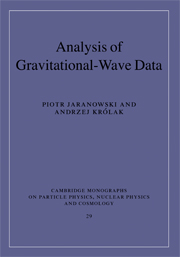Book contents
- Frontmatter
- Contents
- Preface
- Notation and conventions
- 1 Overview of the theory of gravitational radiation
- 2 Astrophysical sources of gravitational waves
- 3 Statistical theory of signal detection
- 4 Time series analysis
- 5 Responses of detectors to gravitational waves
- 6 Maximum-likelihood detection in Gaussian noise
- 7 Data analysis tools
- Appendix A The chirp waveform
- Appendix B Proof of the Neyman–Pearson lemma
- Appendix C Detector's beam-pattern functions
- Appendix D Response of the LISA detector to an almost monochromatic wave
- Appendix E Amplitude parameters of periodic waves
- References
- Index
2 - Astrophysical sources of gravitational waves
Published online by Cambridge University Press: 08 January 2010
- Frontmatter
- Contents
- Preface
- Notation and conventions
- 1 Overview of the theory of gravitational radiation
- 2 Astrophysical sources of gravitational waves
- 3 Statistical theory of signal detection
- 4 Time series analysis
- 5 Responses of detectors to gravitational waves
- 6 Maximum-likelihood detection in Gaussian noise
- 7 Data analysis tools
- Appendix A The chirp waveform
- Appendix B Proof of the Neyman–Pearson lemma
- Appendix C Detector's beam-pattern functions
- Appendix D Response of the LISA detector to an almost monochromatic wave
- Appendix E Amplitude parameters of periodic waves
- References
- Index
Summary
It is convenient to split the expected astrophysical sources of gravitational waves into three main categories, according to the temporal behavior of the waveforms they produce: burst, periodic, and stochastic sources. In Sections 2.1–2.3 of the present chapter we enumerate some of the most typical examples of gravitational-wave sources from these categories (more detailed reviews can be found in [45], Section 9.4 of [16], and [46, 47]). Many sources of potentially detectable gravitational waves are related to compact astrophysical objects: white dwarfs, neutron stars, and black holes. The physics of compact objects is thoroughly studied in the monograph [48].
In the rest of the chapter we will perform more detailed studies of gravitational waves emitted by several important astrophysical sources. In Section 2.4 we derive gravitational-wave polarization functions h+ and h× for different types of waves emitted by binary systems. As an example of periodic waves we consider, in Section 2.5, gravitational waves coming from a triaxial ellipsoid rotating along a principal axis; we derive the functions h+ and h× for these waves. In Section 2.6 we relate the amplitude of gravitational waves emitted during a supernova explosion with the total energy released in gravitational waves and with the time duration and the frequency bandwidth of the gravitational-wave pulse. Finally in Section 2.7 we express the frequency dependence of the energy density of stationary, isotropic, and unpolarized stochastic background of gravitational waves in terms of their spectral density function.
- Type
- Chapter
- Information
- Analysis of Gravitational-Wave Data , pp. 26 - 50Publisher: Cambridge University PressPrint publication year: 2009



